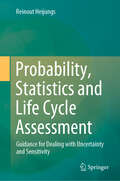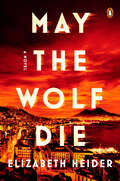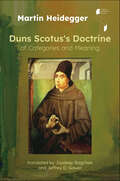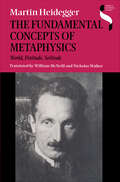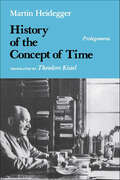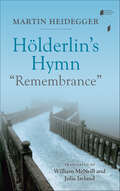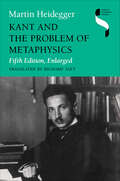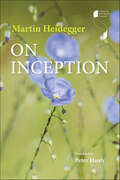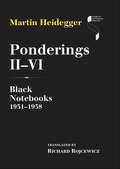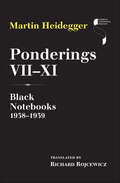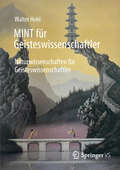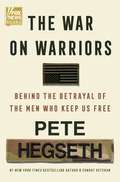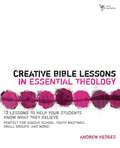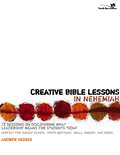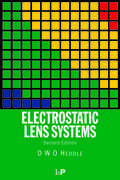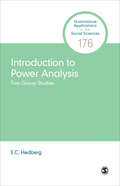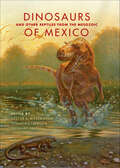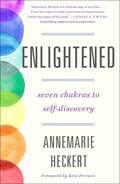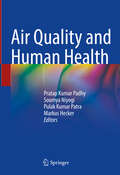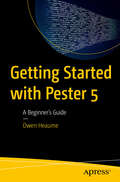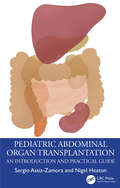- Table View
- List View
Probability, Statistics and Life Cycle Assessment: Guidance for Dealing with Uncertainty and Sensitivity
by Reinout HeijungsThis textbook discusses the use of uncertainty analysis and sensitivity analysis in environmental life cycle assessment (LCA). This is a topic which has received a lot of attention by journals, including the leading (Springer) International Journal of Life Cycle Assessment. Despite its importance, no coherent textbook exists that summarizes the progress that has been made in the last 20 years. This book attempts to fill that gap. Its audience is practitioners (professional and academic) of LCA, teachers, and Ph.D. students. It gives a very broad overview of the field: probability theory, descriptive statistics, inferential statistics, error analysis, sensitivity analysis, decision theory, etc., all in relation to LCA. Much effort has been taken to give a balanced overview, with a uniform terminology and mathematical notation.
May the Wolf Die: A Novel
by Elizabeth HeiderFor readers of Jane Harper, a gripping mystery set in Italy, following a female detective haunted by her family&’s past and tasked with untangling the city&’s organized crime and the modern U.S. military presence there.Nikki Serafino is enjoying the sunset from her boat in her beloved port city of Naples, Italy, when she discovers the body of a man in the warm waters of the bay. An investigator working as the liaison between local police and American troops, Nikki is certainly no stranger to violence and organized crime, but this case grows complicated when the victim turns out to be a U.S. Navy captain stationed at the nearby military base—and the autopsy reveals foul play. As she delves into the case, another body is found and Nikki must face connections linking the murders to her own complicated history as a daughter of Naples. Smart and steeped in sun-soaked Italy, this propulsive mystery is the perfect summer binge read.
Duns Scotus's Doctrine of Categories and Meaning (Studies in Continental Thought)
by Martin HeideggerDuns Scotus's Doctrine of Categories and Meaning is a key text for the origins of Martin Heidegger's concept of "facticity." Originally submitted as a postdoctoral thesis in 1915, it focuses on the 13th-century philosopher-theologian John Duns Scotus. Heidegger first analyzes Scotus's doctrine of categories, then offers a meticulous explanation of the Grammatica Speculativa, a work of medieval grammar now known to be authored by the Modist grammarian Thomas of Erfurt. Taken together, these investigations represent an early foray into Heidegger's lifelong philosophical concerns, "the question of being in the guise of the problem of categories and the question of language in the guise of the doctrine of meaning."This new and unique translation of one of Heidegger's earliest works offers an important look at his early thinking before the question of being became his central concern and will appeal to readers exploring Heidegger's philosophical development, medieval philosophy, phenomenological interpretations of the history of philosophy, and the philosophy of language.
The Fundamental Concepts of Metaphysics: World, Finitude, Solitude (Studies in Continental Thought)
by Martin Heidegger" . . an important addition to the translations of Heidegger's lecture-courses . . Heidegger's voice can be heard with few of the jolting Germanicisms with which so many translations of Heidegger's texts have been burdened. . . ." —International Philosophical Quarterly"The translators of these lectures have succeeded splendidly in giving readers an intimation of the tensely insistent tone of the original German. Heidegger's concern with a linguistic preconsciousness and with our entrancement before the enigma of existence remains intensely contemporary." —Choice"There is much that is new and valuable in this book, and McNeill and Walker's faithful translation makes it very accessible." —Review of Metaphysics"Whoever thought that Heidegger . . . has no surprises left in him had better read this volume. If its rhetoric is 'hard and heavy' its thought is even harder and essentially more daring than Heideggerians ever imagined Heidegger could be." —David Farrell KrellFirst published in German in 1938 as volume 29/30 of Heidegger's collected works, The Fundamental Concepts of Metaphysics includes an extended treatment of the history of metaphysics and an elaboration of a philosophy of life and nature. Heidegger's concepts of organism, animal behavior, and environment are uniquely developed and defined with intensity.This work, the text of Martin Heidegger's lecture course of 1929/30, is crucial for an understanding of Heidegger's transition from the major work of his early years, Being and Time, to his later preoccupations with language, truth, and history. First published in German in 1983 as volume 29/30 of Heidegger's collected works, The Fundamental Concepts of Metaphysics includes an extended treatment of the history of metaphysics and an elaboration of a philosophy of life and nature. Heidegger's concepts of organism, animal behavior, and environment are uniquely developed and defined with intensity.
Hegel's Phenomenology of Spirit (Studies in Phenomenology & Existential Philosophy)
by Martin HeideggerThe text of Martin Heidegger's 1930-1931 lecture course on Hegel's Phenomenology of Spirit contains some of Heidegger's most crucial statements about temporality, ontological difference and dialectic, and being and time in Hegel. Within the context of Heidegger's project of reinterpreting Western thought through its central figures, Heidegger takes up a fundamental concern of Being and Time, "a dismantling of the history of ontology with the problematic of temporality as a clue." He shows that temporality is centrally involved in the movement of thinking called phenomenology of spirit.
History of the Concept of Time: Prolegomena (Studies in Continental Thought)
by Martin HeideggerHeidegger's lecture course at the University of Marburg in the summer of 1925, an early version of Being and Time (1927), offers a unique glimpse into the motivations that prompted the writing of this great philosopher's master work and the presuppositions that gave shape to it. The book embarks upon a provisional description of what Heidegger calls "Dasein," the field in which both being and time become manifest. Heidegger analyzes Dasein in its everydayness in a deepening sequence of terms: being-in-the-world, worldhood, and care as the being of Dasein. The course ends by sketching the themes of death and conscience and their relevance to an ontology that makes the phenomenon of time central. Theodore Kisiel's outstanding translation premits English-speaking readers to appreciate the central importance of this text in the development of Heidegger's thought.
Hölderlin's Hymn "Remembrance" (Studies in Continental Thought)
by Martin HeideggerMartin Heidegger's 1941–1942 lecture course on Friedrich Hölderlin's hymn, "Remembrance," delivered immediately following his confrontation with Nietzsche, lays out a detailed plan for the interpretation of Hölderlin's poetry in which remembrance is a central concern. With its emphasis on the "free use of the national" and the "holy of the fatherland," the course marks an important progression in Heidegger's political thought. In addition to its startlingly innovative analyses of greeting, the festive, and the dream, the text provides Heidegger's fullest elaboration of the structure of commemorative thinking in relationship to time and the possibility of an "other beginning." This English translation by William McNeill and Julia Ireland completes the series of Heidegger's major lecture courses on Hölderlin.
Kant and the Problem of Metaphysics (Studies in Continental Thought)
by Martin HeideggerSince its original publication in 1929, Martin Heidegger's provocative book on Kant's Critique of Pure Reason has attracted much attention both as an important contribution to twentieth-century Kant scholarship and as a pivotal work in Heidegger's own development after Being and Time. This fifth, enlarged edition includes marginal notations made by Heidegger in his personal copy of the book and four new appendices—Heidegger's postpublication notes on the book, his review of Ernst Cassirer's Philosophy of Symbolic Forms, Heidegger's response to reviews by rudolf Odebrecht and Cassirer, and an essay "On the History of the Philosophical Chair since 1866." The work is significant not only for its illuminating assessment of Kant's thought but also for its elaboration of themes first broached in Being and Time, especially the problem of how Heidegger proposed to enact his destruction of the metaphysical tradition and the role that his reading of Kant would play therein.
On Inception (Studies in Continental Thought)
by Martin HeideggerOn Inception is a translation of Martin Heidegger's ber den Anfang (GA 70). This work belongs to the crucial period, before and during WWII, when Heidegger was at work on a series of treatises that begins with "Contributions to Philosophy" and includes "The Event" and "The History of Beyng." These works are difficult, even hermetic, but represent a crucial development in Heidegger's thinking. On Inception deepens the investigation underway in the other volumes of the series and provides a unique perspective on Heidegger's thinking of Being and of Event. Here, Heidegger asks, with a greater insistence than anywhere else in his work, what it might mean to think of being as event, and not as presence. Event cannot be thought without the sense of a beginning—an inception—and so, Heidegger insists, we must try to think of being as inception, as fundamentally inceptive. On Inception pursues rigorously the difficult and puzzling implications of this speculation. It does not merely extend work already undertaken but also opens doors onto wholly other pathways.
Ponderings II–VI: Black Notebooks, 1931–1938 (Studies in Continental Thought)
by Martin HeideggerPonderings II–VI begins the much-anticipated English translation of Martin Heidegger's "Black Notebooks." In a series of small notebooks with black covers, Heidegger confided sundry personal observations and ideas over the course of 40 years. The five notebooks in this volume were written between 1931 and 1938 and thus chronicle Heidegger's year as Rector of the University of Freiburg during the Nazi era. Published in German as volume 94 of the Complete Works, these challenging and fascinating journal entries shed light on Heidegger's philosophical development regarding his central question of what it means to be, but also on his relation to National Socialism and the revolutionary atmosphere of the 1930s in Germany. Readers previously familiar only with excerpts taken out of context may now determine for themselves whether the controversy and censure the "Black Notebooks" have received are deserved or not. This faithful translation by Richard Rojcewicz opens the texts in a way that captures their philosophical and political content while disentangling Heidegger's notoriously difficult language.
Ponderings VII–XI: Black Notebooks, 1938–1939 (Studies in Continental Thought)
by Martin HeideggerThrough these broad and sprawling notebooks, Heidegger offers fascinating opinions on Holderlin, Nietzsche, Wagner, Wittgenstein, Pascal, and many others. The importance of the Black Notebooks transcends Heidegger's relationship with National Socialism. These personal notebooks contain reflections on technology, art, Christianity, the history of philosophy, and Heidegger's attempt to move beyond that history into another beginning.
Ponderings XII–XV: Black Notebooks, 1939–1941 (Studies in Continental Thought)
by Martin HeideggerPonderings XII–XV is third in a series of four "Black Notebooks" which Martin Heidegger composed in the early years of World War II. As always with Heidegger, the thoughts expressed here are not superficial reflections on current events, but instead penetrate deeply into them in order to contemplate their historical importance. Throughout his ponderings, Heidegger meditates on the call for an antidote to the rampant technological attitude which views all things with a dismissive consumer mentality. Although this volume caused quite a scandal when originally published in German due to references to World-Judaism, English readers with access to the full text can now judge for themselves what Heidegger means in his use of that term. In style, this notebook is less aphoristic and more sustained than the previous ones, but remains probing, challenging, and fascinating.
MINT für Geisteswissenschaftler: Naturwissenschaften für Geisteswissenschaftler
by Walter HehlDer Beginn von Naturwissenschaft und Geisteswissenschaft in der Antike war gemeinsam, aber die Naturwissenschaft hatte sich bis zum Ende des 19. Jahrhundert durch ihre Erfolge dominant entwickelt. Gegen diese Dominanz prägte der Philosoph Wilhelm Dilthey 1883 den Begriff der Geisteswissenschaften. In den Naturwissenschaften war es andrerseits klar, dass ganze Bereiche des Geistes den Naturwissenschaften nicht zugänglich waren, etwa sinnliche Empfindungen und das Bewusstsein.Das Buch versucht zu zeigen, dass dieser harte Gegensatz weicher geworden ist. Die Physik ist geistiger geworden und die Technologie des Geistes hat sich entwickelt: Es ist im Grundsatz die Informationstechnologie. Mit der Mathematik als Fundament und als Hilfsmittel ergibt dies MINT.Ein geistiges Weltbild ohne MINT ist in Würde nicht möglich. Es gibt eine Reihe von MINT-Bereichen, die unmittelbar geisteswissenschaftlich von Nutzen sind. Beispiele sind etwa das Prinzip des Lasers undder Begriff der Entropie. Ein dritter, geistiger Bereich bleibt außerhalb: die Kunst. Aber Kunst und MINT sind keine Gegensätze.
The War on Warriors: Behind the Betrayal of the Men Who Keep Us Free
by Pete HegsethReal men fought for our freedoms. It’s time we fought for theirs. <P><P> Pete Hegseth joined the Army to fight extremists. Then that same Army called him one. The military Pete joined twenty years ago was fiercely focused on lethality, competency, and color blindness. Today our brass are following the rest of our country off the cliff of cultural chaos and weakness. <P><P> Americans with common sense are fighting this on many fronts, but if we can’t save the meritocracy of our military, we’re definitely going to lose everywhere else. <P><P> The War on Warriors uncovers the deep roots of our dysfunction—a society that has forgotten the men who take risks, cut through red tape, and get their hands dirty. The only kind of men prepared to face the dangers that the Left pretends don’t exist. Unlike issues of education or taxes or crime, this problem doesn’t have a zip code solution. We can’t move away from it. We can’t avoid it. We have only one Pentagon. Either we take it back or surrender it altogether. <P><P> Combining his own war experiences, tales of outrage, and an incisive look at how the chain of command got so kinked, this book is the key to saving our warriors—and winning future wars. The War on Warriors must be won by the good guys, because when the shooting really starts, they’re the only ones who can save us. <p> <b>New York Times Bestseller</b>
Match Me If You Can
by Swati HegdeA young magazine writer in Mumbai must prove her matchmaking skills—and contend with growing feelings for her close family friend—in this debut desi romance.&“A delightful friends-to-lovers romance that will curb your sweet tooth and leave you feeling warm and happy!&”—New York Times bestselling author Sarah AdamsConfident fashionista Jia Deshpande spends her days writing cliché-ridden listicles for Mimosa, Mumbai&’s top women&’s magazine. When she can, Jia dishes about the messy truth of real love on her anonymous blog, attends her family&’s weekly game nights, and ignores her true feelings for her childhood friend. If that wasn&’t enough, Jia needs to successfully set up a coworker with her perfect match to get the green light for her new matchmaking column. Thankfully, organizing meet-cutes has never been difficult for her. Local pub owner and cocktail genius Jaiman Patil can&’t help but be enamored with Jia and her meddling spirit. He&’s always been an honorary part of her family, but even more so since his own moved to America. Life with the Deshpandes is chaotic and loud, but it&’s also more loving than anything he experienced growing up, and he wouldn&’t risk losing that for the world. It feels manageable—until his pub begins to struggle and his long-hidden feelings for Jia grow deeper. When Jia&’s attempts at office matchmaking go haywire, risking new friendships and her relationship with Jaiman, she must reevaluate her own thoughts on love. For the first time, Jia Deshpande realizes that love may be a lot more complicated than she thought. Luckily, happily-ever-afters are never in short supply in Mumbai.
Creative Bible Lessons in Essential Theology: 12 Lessons to Help Your Students Know What They Believe (Creative Bible Lessons)
by Andrew A. HedgesAs a youth worker you have certainly spent much of your time addressing the current issues facing teens, but have you stopped to think about what may be behind students&’ behavior? Many of the not-so-wise choices students make are the result of a confused worldview that comes from uncertainty about who God is. It&’s easy for students to dismiss the truth when they learn from the world that all truth is relative. Creative Bible Lessons: Essential Theology uses a conversational approach to give students a theological foundation to better understand God and his purpose for how to live their lives. Throughout the twelve sessions of this study students will— • learn how creation provides evidence of God&’s existence. • look at how God has chosen to reveal himself through his Word. • learn to live lives that reflect God&’s love for them. • understand their need for God&’s direction. • commit to following God&’s will as they make life decisions. • discover how God&’s invitation to enter his kingdom affects the direction of their lives. • examine where they are with God on a personal level. Following in the tradition of the bestselling Creative Bible Lessons series, you&’ll find audio, visual, and hands-on activities to engage your students in the pursuit of theology. And because every student learns differently, each lesson includes options to help you reach your particular group of students, whether they learn best from imaginative, analytic, common sense, or dynamic teaching styles. With all these tools at your disposal you are guaranteed to get your students fired-up for seeking God and his plan for them.
Creative Bible Lessons in Nehemiah: 12 Sessions on Discovering What Leadership Means for Students Today (Creative Bible Lessons)
by Andrew A. HedgesWe may think of them as the leaders of tomorrow, but the kids you minister to are already leaders—they’re the leaders of today. In hallways, on playing fields, and in their own homes, students are influencing the lives that surround them.Nehemiah is one of the Bible’s most powerful examples of what a godly leader looks like. This newest collection of Creative Bible Lessons helps your students connect with this ancient figure in a way that is both engaging and relevant.Each session focuses on one chapter of the Old Testament book by using activities that emphasize four different learning styles—thereby ensuring that your students hear what they need to hear in ways they need to hear it. The session titles include:A Leader Passionately PraysA Leader Teaches TruthA Leader Walks the WalkA Leader Instills IntegrityA Leader Hungers for HolinessEach session also offers an overview, a list of things you’ll need, background information on the Nehemiah chapter, openers, plenty of questions, and application options such as games, discussion starters, and small group activities that help the meaning of Nehemiah stick in your students’ heads.Creative Bible Lessons in Nehemiah will get your students thinking about the kinds of leaders God is calling them to be and provide them with the tools to be that leader…today.
Electrostatic Lens Systems, 2nd edition
by D.W.O. HeddleThis second edition enables readers to design lens systems for focusing beams of charged particles that have useful characteristics. The book covers the basic theory of the motion of charged particles in electrostatic fields and describes several methods for the calculation of the potential and field distribution for various electrode geometries. It emphasizes the Bessel function expansion method and the nine-point implementation of the finite difference method. The accompanying disk provides a suite of computer programs (LENSYS for MS-DOS) intended for practical use in the design and analysis of systems using round lenses with apertures or cylindrical elements.
Introduction to Power Analysis: Two-Group Studies (Quantitative Applications in the Social Sciences #176)
by E. C. HedbergIntroduction to Power Analysis: Two-Group Studies provides readers with the background, examples, and explanation they need to read technical papers and materials that include complex power analyses. This clear and accessible guide explains the components of test statistics and their sampling distributions, and author Eric Hedberg walks the reader through the simple and complex considerations of this research question. Filled with graphics and examples, the reader is taken on a tour of power analyses from covariates to clusters, seeing how the complicated task of comparing two groups, and the power analysis, can be made easy.
Introduction to Power Analysis: Two-Group Studies (Quantitative Applications in the Social Sciences #176)
by E. C. HedbergIntroduction to Power Analysis: Two-Group Studies provides readers with the background, examples, and explanation they need to read technical papers and materials that include complex power analyses. This clear and accessible guide explains the components of test statistics and their sampling distributions, and author Eric Hedberg walks the reader through the simple and complex considerations of this research question. Filled with graphics and examples, the reader is taken on a tour of power analyses from covariates to clusters, seeing how the complicated task of comparing two groups, and the power analysis, can be made easy.
Dinosaurs and Other Reptiles from the Mesozoic of Mexico (Life of the Past)
by Héctor E. Rivera-Sylva, Kenneth Carpenter and Eberhard FreyThis overview of dinosaur discoveries in Mexico synthesizes current information about the geography and environment of the region during the Mesozoic when it was the western margin of the ancient continent of Pangea. The book summarizes research on various groups, including turtles, lepidosauromorphs, plesiosaurs, crocodyliforms, pterosaurs, and last but not least, dinosaurs. In addition, chapters focus on trackways and other trace fossils and on K/P boundary (the Chicxulub crater, beneath the Gulf of Mexico, has been hypothesized as the site of the boloid impact that killed off the dinosaurs). Dinosaurs and Other Reptiles from the Mesozoic of Mexico is an up-to-date, informative volume on an area that has not been comprehensively described until now.
Enlightened: Seven Chakras to Self-Discovery
by Annemarie HeckertWorld-renowned Medium Annemarie Heckert leads readers on a healing journey through the chakras in her debut book, Enlightened. Bringing her prodigious clairvoyance skills to bear on the subject of emotional healing, Annemarie offers a unique look at the role of the chakras in affecting how grief and trauma is stored in our bodies. Enlightened takes readers through each of the seven chakras, revealing their unique function and meaning.Born with the ability to communicate with angels and spirits, Annemarie is a highly sought-after Medium whose deeply insightful readings help clients connect with their guardian angels and deceased loved ones for clarity, comfort, and guidance. She pairs her clairvoyance with her deep knowledge of the chakra system to provide clients with incredibly unique and comprehensive spiritual counseling.Now, drawing from over 25,000 consultations performed to date, Annemarie shares a selection of unforgettable client stories to give readers a glimpse into her life as a clairvoyant and provide unique lessons on spiritual development. With humor and grace, Enlightened introduces readers to Annemarie’s gifts, and opens them up to the possibilities of their own Heavenly connections.
Air Quality and Human Health
by Markus Hecker Pratap Kumar Padhy Soumya Niyogi Pulak Kumar PatraThe book is one of the outcomes of the SPARC (Scheme for Promotion of Academic and Research Collaboration) project titled "Fine particulates matters in the air environment and their cancer risks in human beings," sponsored by MHRD (now MoE), Govt. of India. The editors of the book are PIs and Co-PIs of the said project. The text deliberates on air pollution's health risks with contributions from well-known experts from diverse research fields (environmental science, toxicology, geology, public health science, biology, physics, chemistry, and geospatial technology). It explores it its control and mitigation strategies. The book provides an up-to-date overview of the modern methods and tools used in air quality monitoring and human health risk assessment. Case studies from different global settings offer invaluable insights into air pollution-related regional health issues. It addresses all aspects of air quality, covering indoor-outdoor air pollution, gaseous and particulate pollutants; characterization of source and pathways of air pollutants; and the modeling and assessing of health risks (respiratory, epidemiological, and toxicological) with regional and global perspectives. It also addresses air quality management issues. The lucid explanation of the role of oxidative stress mechanisms and molecular biomarkers (genomics, proteomics) may be considered as inputs into the development of cancer therapeutics. Along with providing a scientific basis for air pollution, this book will help readers appreciate the environmental determinants of public health and apply research evidence to improve the quality of life. It also delineates future research initiatives and policy actions needed to protect human health from air pollution, locally and globally. The book will be of great educational value and help for consultation and teaching.
Getting Started with Pester 5: A Beginner's Guide
by Owen HeaumeEmbark on a transformative journey into the world of Pester and elevate your PowerShell scripting to new heights of robustness, reliability, and efficiency. This comprehensive beginner's guide provides a hands-on approach to PowerShell testing using Pester, empowering you to enhance your code quality with confidence.The book starts with an introduction to Pester, the powerful testing and mocking framework for PowerShell. You'll gain a solid foundation by exploring Pester's fundamental building blocks. The book guides you through the phases of Pester, helping you write your initial Pester code. You will dive into topics such as tags, assertions with Should and parameter filters, and you will explore advanced techniques such as Test Drive and Test Registry.You will discover the art of mocking in Pester and master its advanced testing methodologies. You will gain insights into working without installed modules and seamlessly integrating Pester with Azure DevOps Pipeline for a streamlined testing process.After reading this book, you will have the knowledge and skills to initiate your own exploration into PowerShell testing with Pester. You will transform your scripts into reliable powerhouses, ensuring the resilience and quality of your PowerShell code.What Will You LearnBuilding blocks and phases of PesterWriting effective Pester testsAssertions, mocking, and advanced testing techniquesIntegration with Azure DevOpsTags, code coverageWho This Book Is ForPowerShell scripters and Pester Framework beginners
Pediatric Abdominal Organ Transplantation: An Introduction and Practical guide
by Nigel Heaton Sergio Assia-ZamoraPediatric abdominal organ transplantation is a complex procedure that requires a multidisciplinary team to ensure that outcomes are consistently excellent. This book highlights the surgical point of view of the surgical aspects of multiorgan transplantation. It is intended to deepen the knowledge of these types of transplants for medical students, nurses, doctors, and anaesthetists. This book will serve to expand the understanding of the general concepts of pediatric abdominal transplantation, focusing on the indications, surgical techniques, and complications of each type of graft for all multidisciplinary team members.
